child restraint TOYOTA GT86 2014 Owners Manual
[x] Cancel search | Manufacturer: TOYOTA, Model Year: 2014, Model line: GT86, Model: TOYOTA GT86 2014Pages: 464, PDF Size: 10.65 MB
Page 2 of 464

TABLE OF CONTENTSIndex
2
1-1. Key information
Keys ...................................... 30
1-2. Opening, closing and
locking the doors and
trunk
Smart entry & start
system ................................ 33
Wireless remote control ........ 51
Doors .................................... 55
Trunk..................................... 58
1-3. Adjustable components
(seats, mirrors,
steering wheel)
Front seats ............................ 63
Rear seats ............................ 67
Head restraints ..................... 69
Seat belts .............................. 71
Steering wheel ...................... 78
Anti-glare inside rear view
mirror .................................. 79
Outside rear view
mirrors ................................ 80
1-4. Opening and closing
the windows
Power windows ..................... 83
1-5. Refueling
Opening the fuel
tank cap .............................. 871-6. Theft deterrent system
Engine immobilizer
system................................ 91
Double locking system ....... 100
1-7. Safety information
Correct driving posture ....... 102
SRS airbag
(Supplemental Restraint
System airbag) ................. 104
Child restraint systems ....... 133
Installing child
restraints .......................... 141
Airbag manual on-off
system.............................. 151
2-1. Driving procedures
Driving the vehicle .............. 156
Engine (ignition) switch
(vehicles with a smart
entry & start system) ........ 169
Engine (ignition) switch
(vehicles without a
smart entry &
start system) .................... 178
Automatic transmission ...... 181
Manual Transmission ......... 188
Turn signal lever................. 191
Parking brake ..................... 192
Horn ................................... 193
1Before driving
2When driving
Page 8 of 464
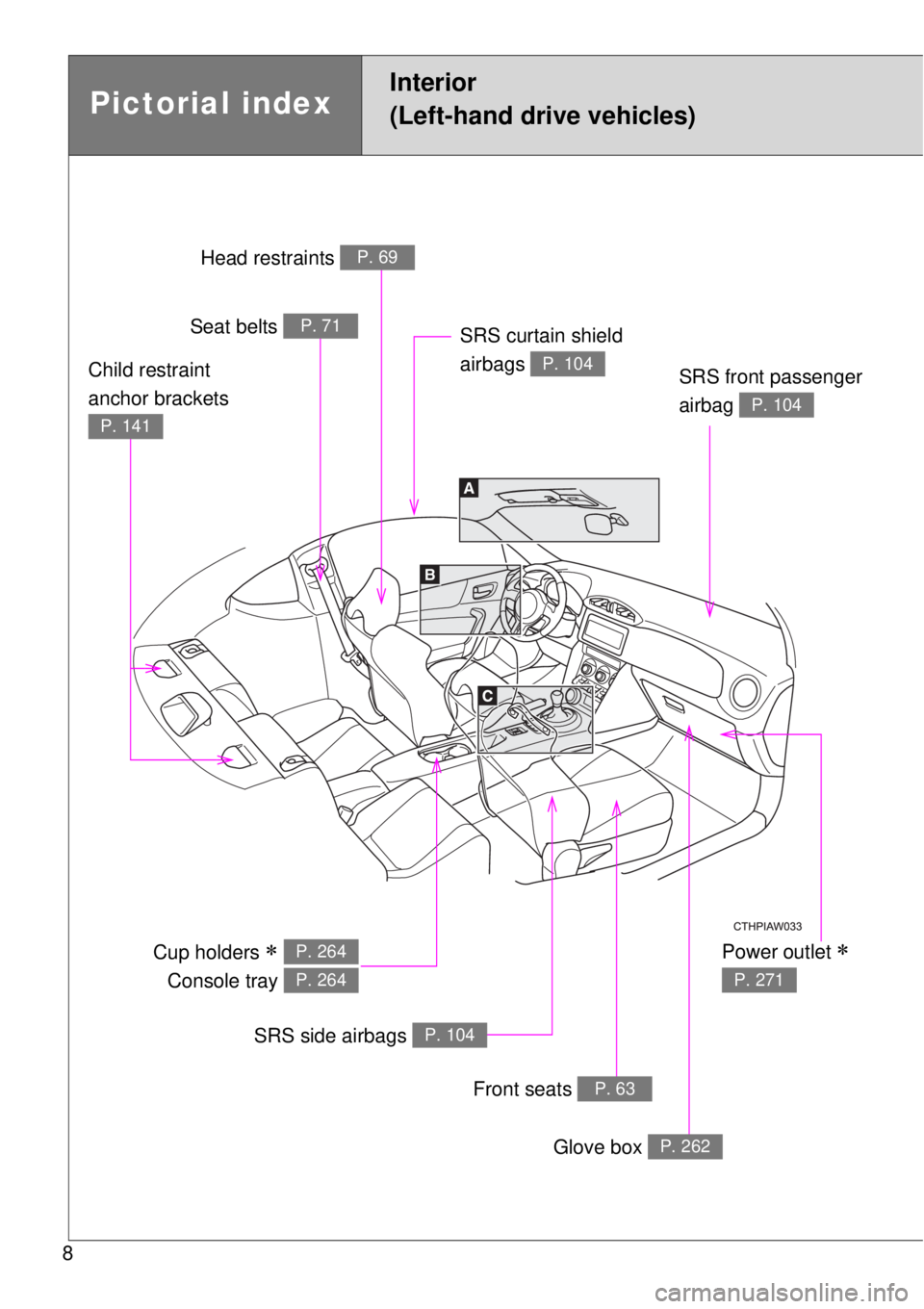
8
Pictorial index
Interior
(Left-hand drive vehicles)
Power outlet
P. 271
Head restraints P. 69
Seat belts P. 71
SRS front passenger
airbag
P. 104
Cup holders
Console tray P. 264
P. 264
SRS side airbags P. 104
Front seats P. 63
Glove box P. 262
SRS curtain shield
airbags
P. 104Child restraint
anchor brackets
P. 141
Page 9 of 464
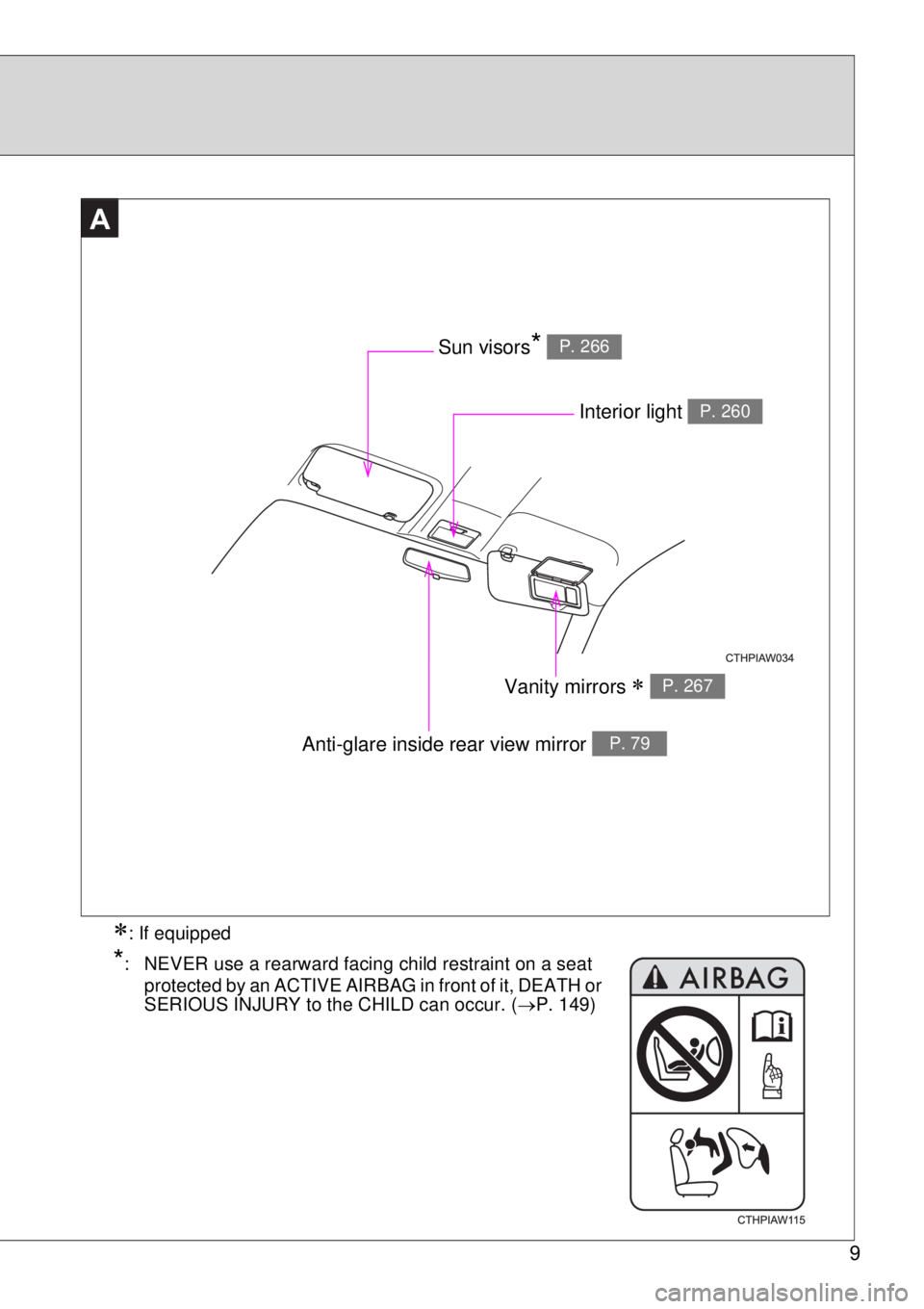
9
AA
Anti-glare inside rear view mirror P. 79
Interior light P. 260
Vanity mirrors P. 267
Sun visors* P. 266
*: NEVER use a rearward facing child restraint on a seat
protected by an ACTIVE AIRBAG in front of it, DEATH or
SERIOUS INJURY to the CHILD can occur. (P. 149)
: If equipped
Page 15 of 464
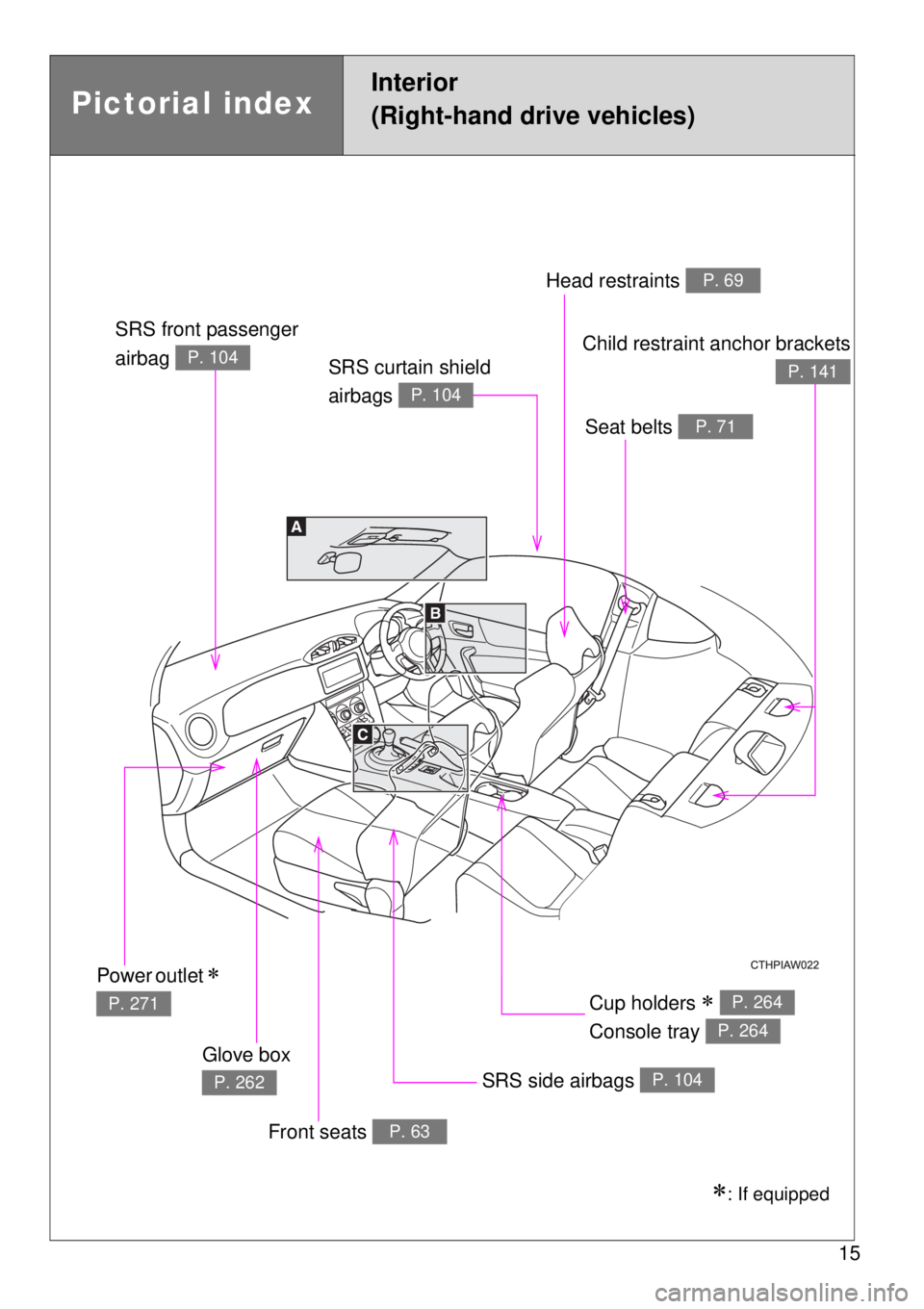
15
Pictorial index
Interior
(Right-hand drive vehicles)
SRS front passenger
airbag
P. 104
Head restraints P. 69
Seat belts P. 71
Child restraint anchor brackets
P. 141
Power outlet
P. 271
Glove box
P. 262
Front seats P. 63
SRS side airbags P. 104
Cup holders
Console tray P. 264
P. 264
SRS curtain shield
airbags
P. 104
: If equipped
Page 16 of 464
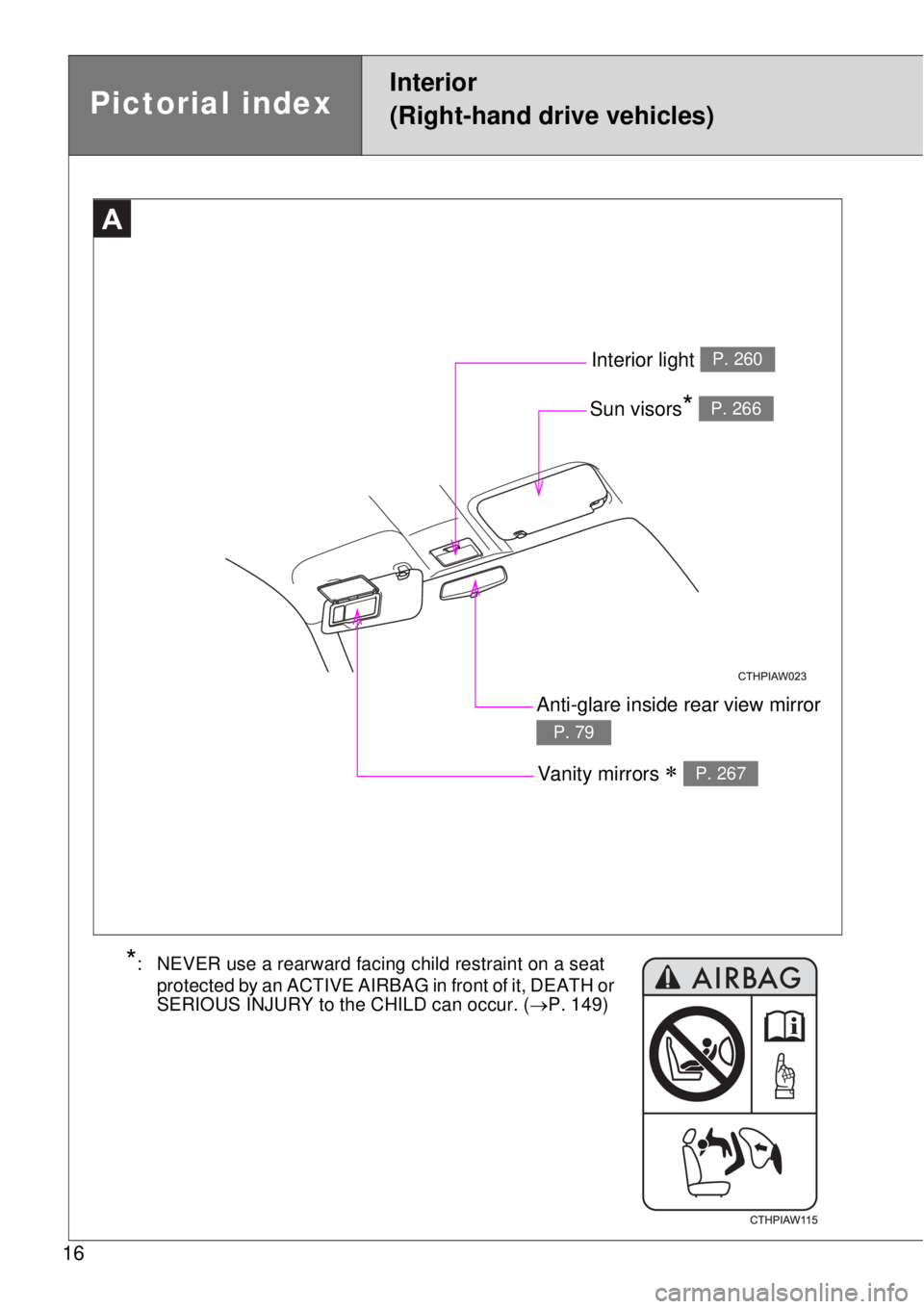
16
A
Anti-glare inside rear view mirror
P. 79
Interior light P. 260
Sun visors* P. 266
Vanity mirrors P. 267
Pictorial index
Interior
(Right-hand drive vehicles)
*: NEVER use a rearward facing child restraint on a seat
protected by an ACTIVE AIRBAG in front of it, DEATH or
SERIOUS INJURY to the CHILD can occur. (P. 149)
Page 29 of 464
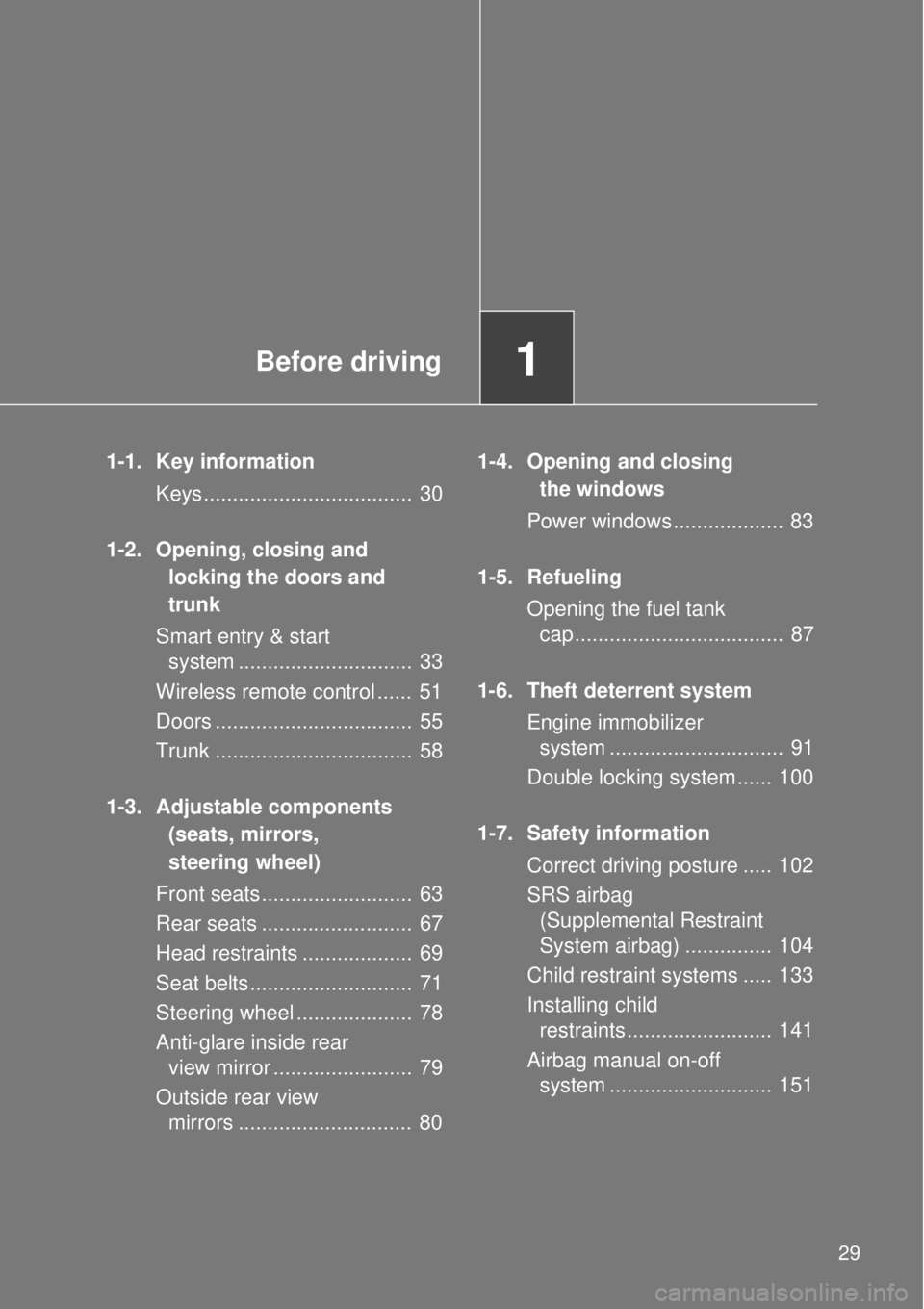
1Before driving
29
1-1. Key information
Keys.................................... 30
1-2. Opening, closing and
locking the doors and
trunk
Smart entry & start
system .............................. 33
Wireless remote control ...... 51
Doors .................................. 55
Trunk .................................. 58
1-3. Adjustable components
(seats, mirrors,
steering wheel)
Front seats.......................... 63
Rear seats .......................... 67
Head restraints ................... 69
Seat belts............................ 71
Steering wheel .................... 78
Anti-glare inside rear
view mirror ........................ 79
Outside rear view
mirrors .............................. 801-4. Opening and closing
the windows
Power windows ................... 83
1-5. Refueling
Opening the fuel tank
cap .................................... 87
1-6. Theft deterrent system
Engine immobilizer
system .............................. 91
Double locking system ...... 100
1-7. Safety information
Correct driving posture ..... 102
SRS airbag
(Supplemental Restraint
System airbag) ............... 104
Child restraint systems ..... 133
Installing child
restraints ......................... 141
Airbag manual on-off
system ............................ 151
Page 73 of 464
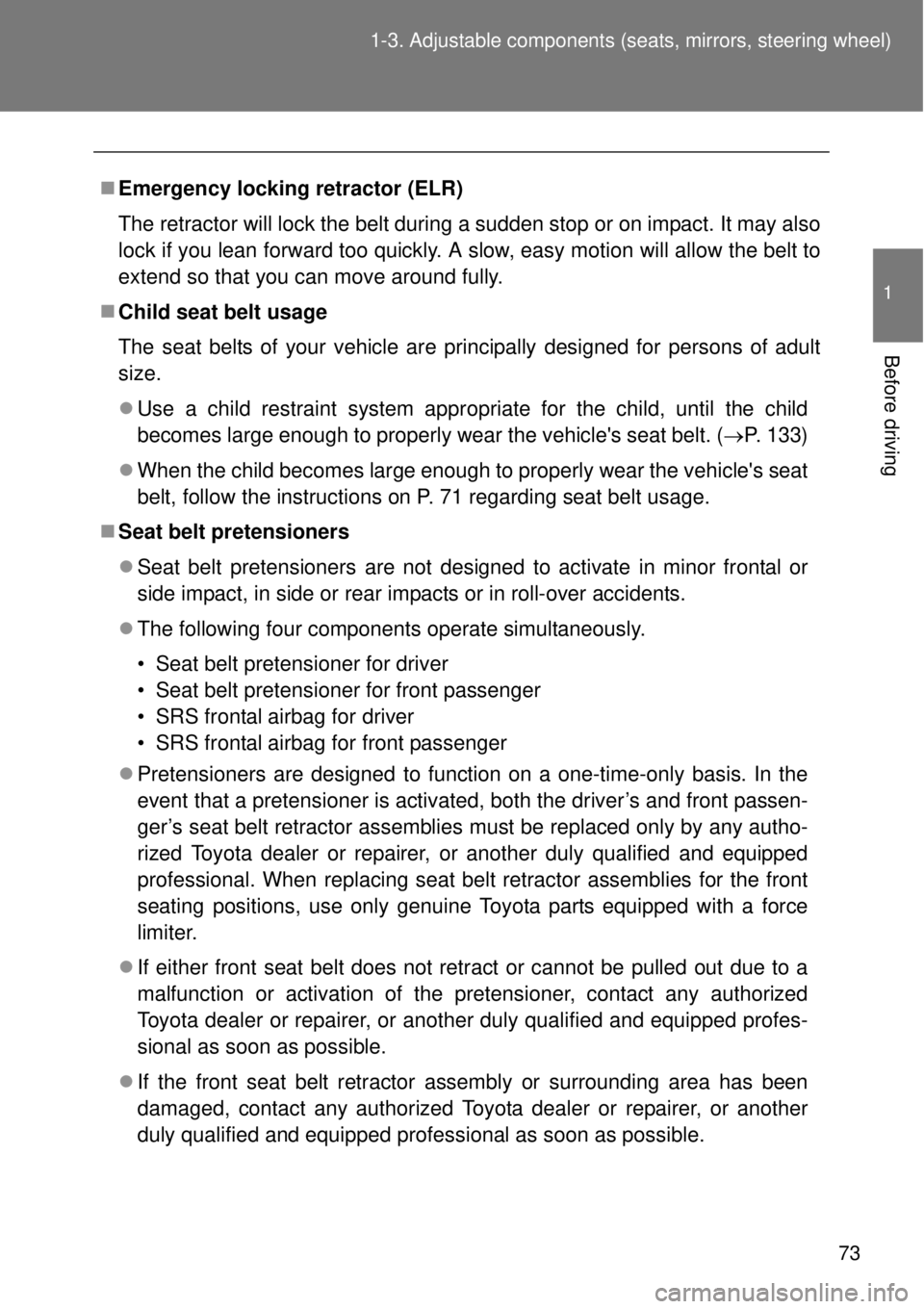
73 1-3. Adjustable components (seats, mirrors, steering wheel)
1
Before driving
Emergency locking retractor (ELR)
The retractor will lock the belt during a sudden stop or on impact. It may also
lock if you lean forward too quickly. A slow, easy motion will allow the belt to
extend so that you can move around fully.
Child seat belt usage
The seat belts of your vehicle are principally designed for persons of adult
size.
Use a child restraint system appropriate for the child, until the child
becomes large enough to properly wear the vehicle's seat belt. (P. 133)
When the child becomes large enough to properly wear the vehicle's seat
belt, follow the instructions on P. 71 regarding seat belt usage.
Seat belt pretensioners
Seat belt pretensioners are not designed to activate in minor frontal or
side impact, in side or rear impacts or in roll-over accidents.
The following four components operate simultaneously.
• Seat belt pretensioner for driver
• Seat belt pretensioner for front passenger
• SRS frontal airbag for driver
• SRS frontal airbag for front passenger
Pretensioners are designed to function on a one-time-only basis. In the
event that a pretensioner is activated, both the driver’s and front passen-
ger’s seat belt retractor assemblies must be replaced only by any autho-
rized Toyota dealer or repairer, or another duly qualified and equipped
professional. When replacing seat belt retractor assemblies for the front
seating positions, use only genuine Toyota parts equipped with a force
limiter.
If either front seat belt does not retract or cannot be pulled out due to a
malfunction or activation of the pretensioner, contact any authorized
Toyota dealer or repairer, or another duly qualified and equipped profes-
sional as soon as possible.
If the front seat belt retractor assembly or surrounding area has been
damaged, contact any authorized Toyota dealer or repairer, or another
duly qualified and equipped professional as soon as possible.
Page 74 of 464
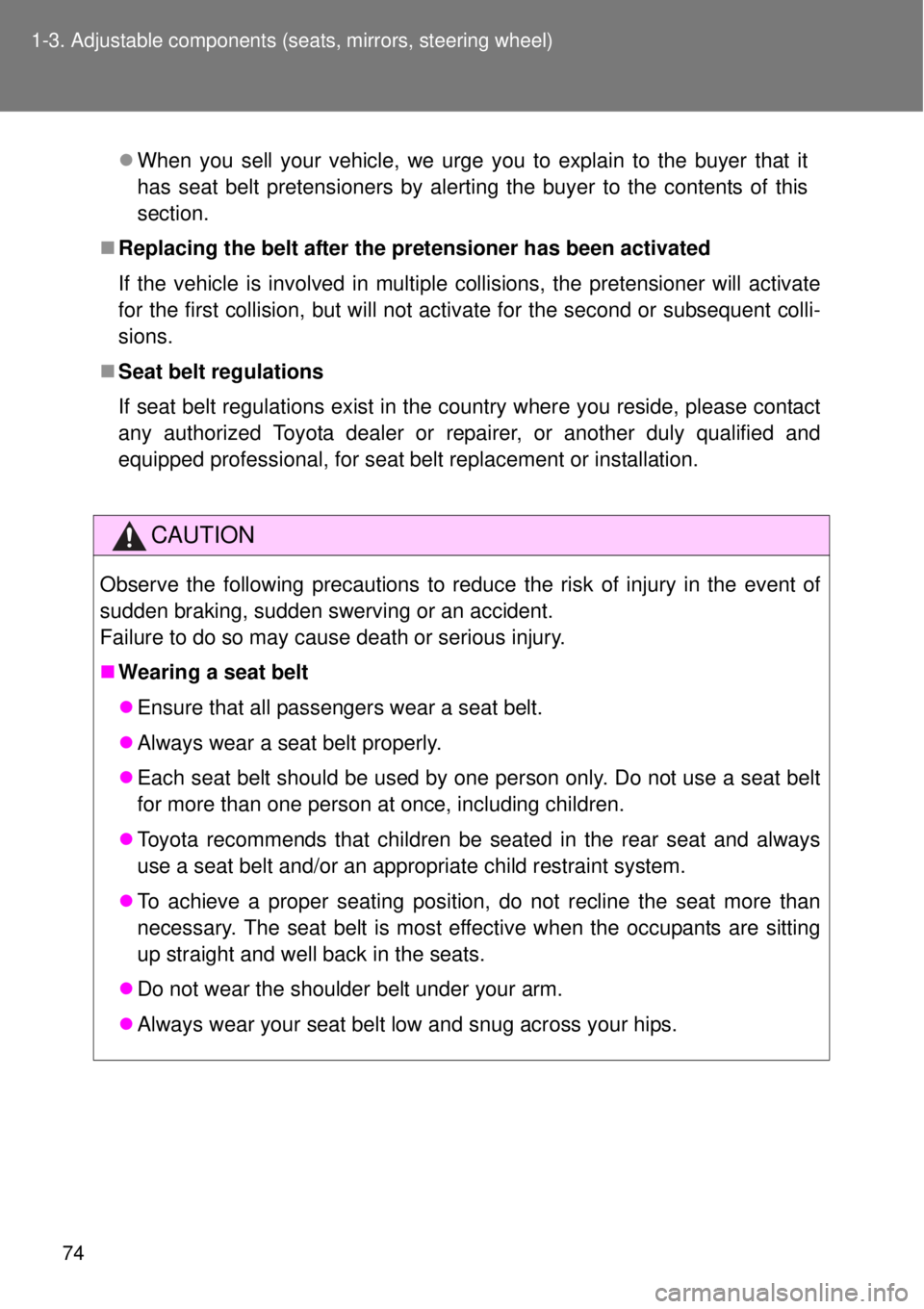
74 1-3. Adjustable components (seats, mirrors, steering wheel)
When you sell your vehicle, we urge you to explain to the buyer that it
has seat belt pretensioners by alerting the buyer to the contents of this
section.
Replacing the belt after the pretensioner has been activated
If the vehicle is involved in multiple collisions, the pretensioner will activate
for the first collision, but will not activate for the second or subsequent colli-
sions.
Seat belt regulations
If seat belt regulations exist in the country where you reside, please contact
any authorized Toyota dealer or repairer, or another duly qualified and
equipped professional, for seat belt replacement or installation.
CAUTION
Observe the following precautions to reduce the risk of injury in the event of
sudden braking, sudden swerving or an accident.
Failure to do so may cause death or serious injury.
Wearing a seat belt
Ensure that all passengers wear a seat belt.
Always wear a seat belt properly.
Each seat belt should be used by one person only. Do not use a seat belt
for more than one person at once, including children.
Toyota recommends that children be seated in the rear seat and always
use a seat belt and/or an appropriate child restraint system.
To achieve a proper seating position, do not recline the seat more than
necessary. The seat belt is most effective when the occupants are sitting
up straight and well back in the seats.
Do not wear the shoulder belt under your arm.
Always wear your seat belt low and snug across your hips.
Page 107 of 464
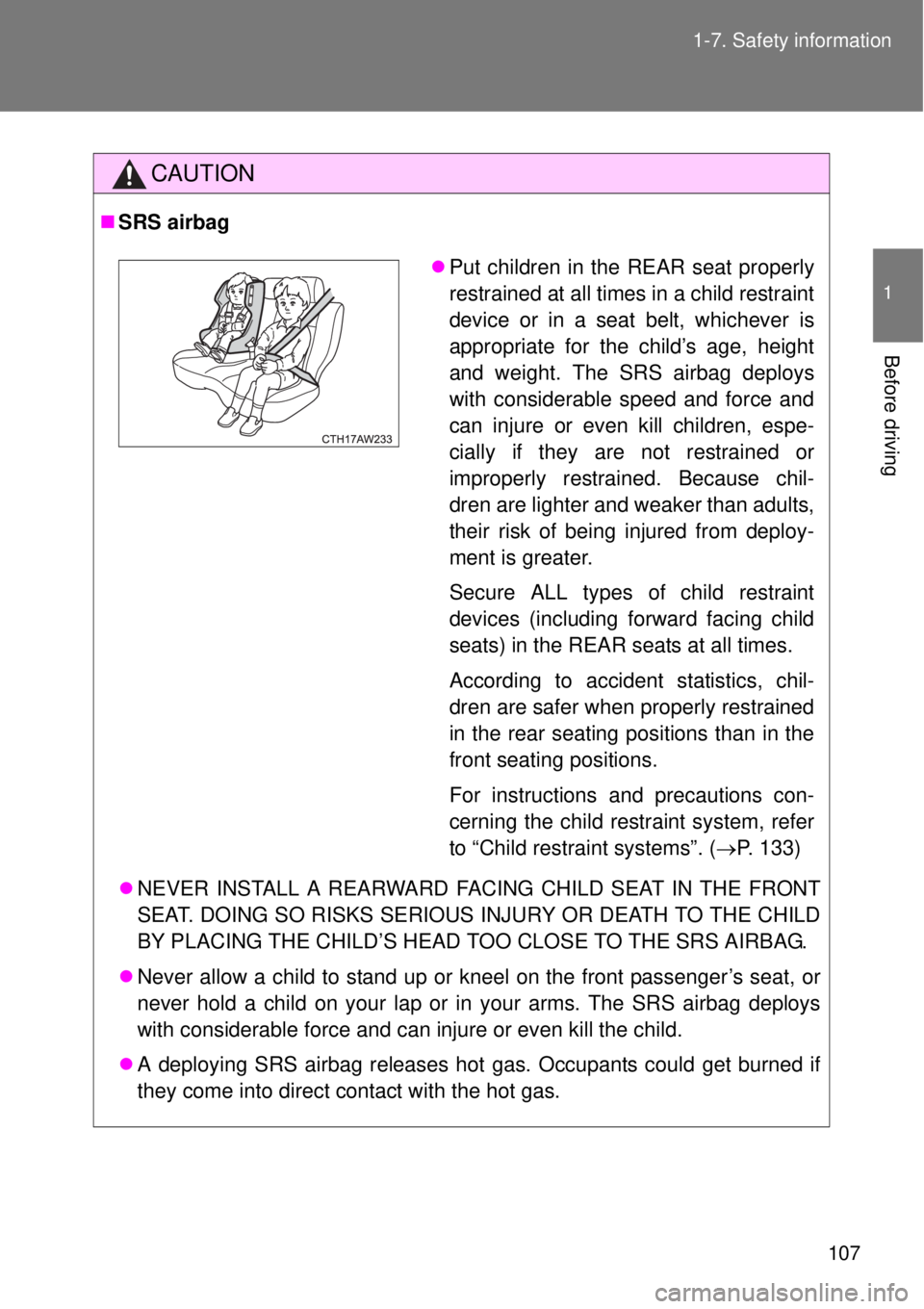
107 1-7. Safety information
1
Before driving
CAUTION
SRS airbag
NEVER INSTALL A REARWARD FACING CHILD SEAT IN THE FRONT
SEAT. DOING SO RISKS SERIOUS INJURY OR DEATH TO THE CHILD
BY PLACING THE CHILD’S HEAD TOO CLOSE TO THE SRS AIRBAG.
Never allow a child to stand up or kneel on the front passenger’s seat, or
never hold a child on your lap or in your arms. The SRS airbag deploys
with considerable force and can injure or even kill the child.
A deploying SRS airbag releases hot gas. Occupants could get burned if
they come into direct contact with the hot gas.
Put children in the REAR seat properly
restrained at all times in a child restraint
device or in a seat belt, whichever is
appropriate for the child’s age, height
and weight. The SRS airbag deploys
with considerable speed and force and
can injure or even kill children, espe-
cially if they are not restrained or
improperly restrained. Because chil-
dren are lighter and weaker than adults,
their risk of being injured from deploy-
ment is greater.
Secure ALL types of child restraint
devices (including forward facing child
seats) in the REAR seats at all times.
According to accident statistics, chil-
dren are safer when properly restrained
in the rear seating positions than in the
front seating positions.
For instructions and precautions con-
cerning the child restraint system, refer
to “Child restraint systems”. (P. 133)
Page 126 of 464
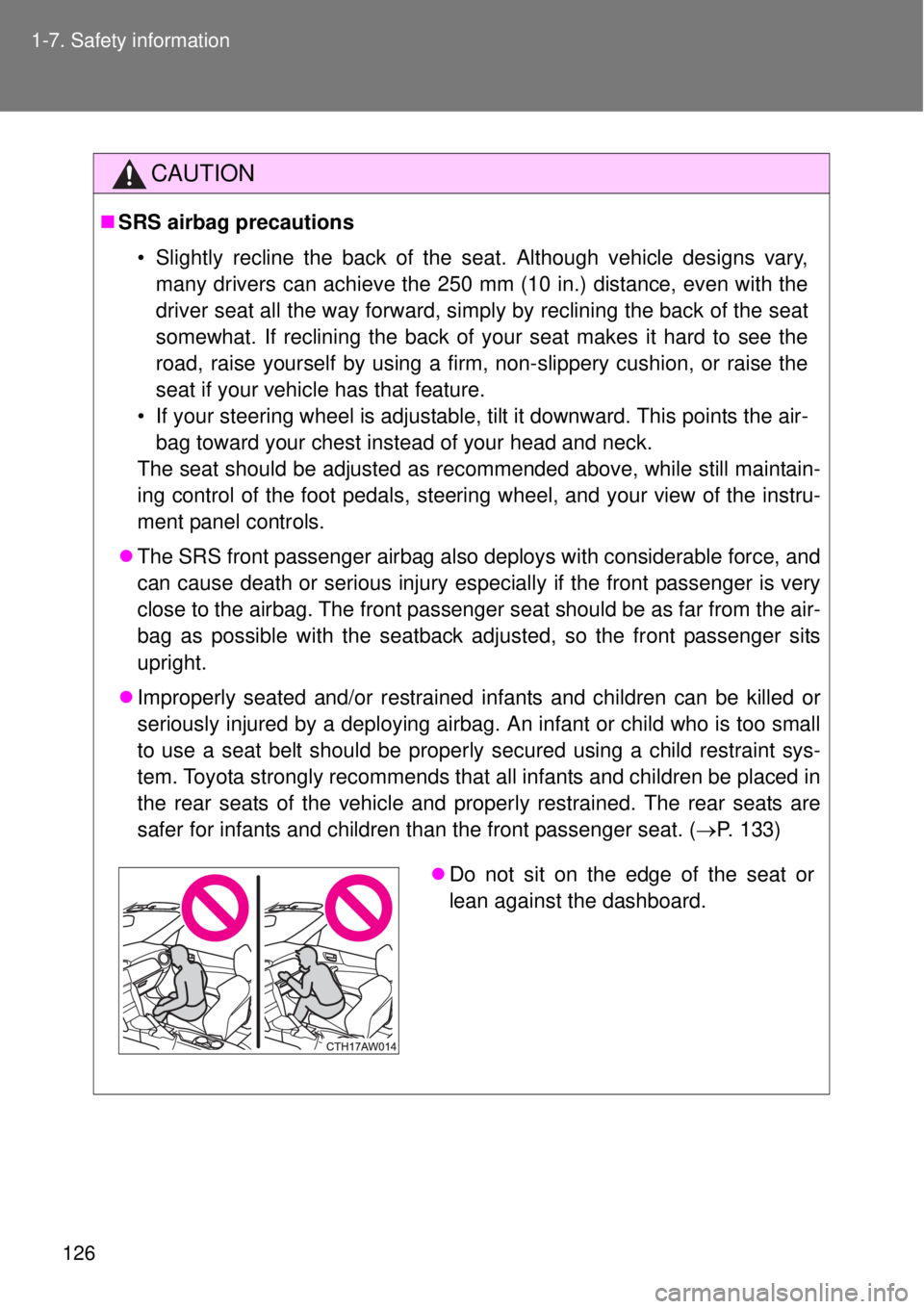
126 1-7. Safety information
CAUTION
SRS airbag precautions
• Slightly recline the back of the seat. Although vehicle designs vary,
many drivers can achieve the 250 mm (10 in.) distance, even with the
driver seat all the way forward, simply by reclining the back of the seat
somewhat. If reclining the back of your seat makes it hard to see the
road, raise yourself by using a firm, non-slippery cushion, or raise the
seat if your vehicle has that feature.
• If your steering wheel is adjustable, tilt it downward. This points the air-
bag toward your chest instead of your head and neck.
The seat should be adjusted as recommended above, while still maintain-
ing control of the foot pedals, steering wheel, and your view of the instru-
ment panel controls.
The SRS front passenger airbag also deploys with considerable force, and
can cause death or serious injury especially if the front passenger is very
close to the airbag. The front passenger seat should be as far from the air-
bag as possible with the seatback adjusted, so the front passenger sits
upright.
Improperly seated and/or restrained infants and children can be killed or
seriously injured by a deploying airbag. An infant or child who is too small
to use a seat belt should be properly secured using a child restraint sys-
tem. Toyota strongly recommends that all infants and children be placed in
the rear seats of the vehicle and properly restrained. The rear seats are
safer for infants and children than the front passenger seat. (P. 133)
Do not sit on the edge of the seat or
lean against the dashboard.